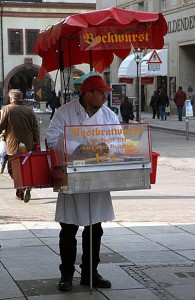 Not that many years ago. Well it was before the advent of the internet being available on a cell phone or perhaps the internet was not available at all. My guess is that this memory is from the mid 1990’s.
Not that many years ago. Well it was before the advent of the internet being available on a cell phone or perhaps the internet was not available at all. My guess is that this memory is from the mid 1990’s.
I was being driven across the German countryside by a good friend named Klaus Wenske. Klaus knows that I like German sausage, and many times he would introduce me to a new wurst. Germany has the best wurst. That day it was Bockwurst. We stopped for lunch at a roadside diner and enjoyed some Bockwurst on a bun with mustard. It was great lunch which included a Bock Beer. I asked Klaus if Bock Beer and Bockwurst had the same origins. He was not sure. He explained that the Bock Beer got its name from the male deer with antlers on the bottle (we say Buck and they say Bock).
He tried several times to come up with plausible explanations for Bockwurst but none was completely believable as he told them without conviction. I guess I chided him a little too much because in a fit of frustration he looked at me and said “I don’t know where the name Bockwurst comes from. Where does the word ‘marshmallow’ come from?” This was a great question as I had no idea. Not to be outdone I grabbed his cell phone and called Peter Reinhard a friend of mine in the USA who knows everything. I was surprised when the question of the origin of the word marshmallow stumped Peter. At home Peter has a great collection of dictionaries and he phoned Margrit, his wife, who looked it up. Now I was prepared! I learned that it is “a confection of sweetened paste, formerly made from the root of the marshmallow plant.” and also learned that it is “a perennial plant (Althaea officinalis) native to Europe and naturalized in marshes of eastern North America, having showy pink flowers and a mucilaginous root occasionally used in confectionery”.
I shared this deep knowledge of the “root” of the word marshmallow with Klaus and asked the question again, “Where does the name Bockwurst come from?”
Klaus still has not told me!


Ok, here you go:
“Bockwurst” has nothing to do with the male deer, called “Bock” in German. Bockwurst is called like that, because this “Wurst” was accompanied by “Bockbier”, a very strong type of beer, which was first brewed in the northern German Town of “Einbeck”. The bavarian Kings liked the northern German beer from the town of Einbeck very much, so the master brewer from Einbeck was asked to do his magic at some of the bavarian castles (around 1550) and he brought of course his beer with him. He called it “Ainpöckisch” beer, which means something like “beer from Einbeck”. The bavarian dialekt formed this word “Ainpöckisch” over the decades to “Bock”, so “Bock” is referring to beer, that originated around the 1500s in the town of Einbeck.
That’s it :)
Hi Michael,
Your answer disagrees a little with that now found in Wikipedia as the Wikipedia says “Bockwurst is a kind of German sausage invented in 1889 by restaurant owner R. Scholtz of Berlin.”
Your answer does agree with an email I received from Jeannette Jacobs of Meica in Germany saying “Legend has it that the bockwurst originated in Einbeck, Lower Saxony, because the famous local “Ainpockisch Beer“ was often served with a tender, juicy boiled sausage – a bockwurst! Meica’s Bockwurst is available in a natural casing that has a nice bite to it. Meica’s Saftbockwurst, on the other hand, comes without casing – skinless.”
I’m guessing that your research is coming close to the facts. Well done!
Bockbier has nothing to do with male deer. A German would never refer to a male deer as a “buck” – that is a typically American word; rather, a German would refer to a male deer as a “Hirschbock” – in American English, a “stag.”
The association to bockbier is, and, since the development of Bavarian bockbier, has always been, to a male “billygoat” [German for “billygoat” = Ziegenbock].
Here is a little history on bockbier – I am an American of German-Bavarian descent who loves bockbier and I learned this history from a Bavarian brewmaster [auf Deutsch (in German), Braumeister] I met while temporarily residing in a small village [auf Deutsch, dorf] about 25 years ago.
Today, most people associate bockbier with the city of Munich, the capital of the southern German State of Bavaria (auf Deutsch, Bayern). Despite this modern association, bockbier originated in northern Germany, in the town of Einbeck in the German region now known as Lower Saxony. Bockbier originated sometime in the middle of the 13th century. At that time, Einbeck was an important member-city of the Hanseatic League, an international trading empire comprising hundreds of powerful medieval merchants. Einbeck’s specialty export within the League was a strong dark ale made from wheat and barley and what, in the beer brewing industry, are called “top-fermenting yeasts.” At that time, virtually every inhabitant of Einbeck was directly or indirectly engaged in the brewing trade. One of the principal customers of the Einbeck brewers was the House of Wittelsbach, the ruling family of Bavaria. Over time, the ruling family of Bavaria and the members of their households, in conjunction with the dukes and other powerful members of Bavarian society, again in conjunction with the members of their households, consumed such a quantity of Einbeck ale on such a regular basis that money was flowing out of Bavaria and into Lower Saxony, creating financial and economic problems, or, at least, concerns in Bavaria.
Sometime around the end of the 1500s, probably about 1590, to remedy this “trade deficit” and its consequent affect on the Bavarian money supply, the then Bavarian ruler, Duke Wilhelm V, had an Einbeck-like, strong, brown to red ale brewed in a brewhouse Duke Wilhelm built in Landshut, a town (auf Deutsch, “dorf”) located about 50 miles northeast of Munich. The Duke established this brewery with the hope the product would recapture the beer market and keep the money being spent on Einbeck beer in Bavaria. Approximately one year later, Duke Wilhelm completed another brewhouse intended to brew the new beer. Duke Wilhelm built this second brewery in the center of Munich (this brew house is currently the site of the now-famous Hofbräuhaus).
At the beginning of Duke Wilhelm’s brewery venture, the breweries supplied the Bavarian brew only to members of the nobility. Things changed about 20 years later, though. Duke Wilhelm allowed the breweries to begin supplying the local innkeepers and private households. As a consequence, the “trade deficit” resulting from the inflow of Einbeck beer, and its consequent outflow of Bavarian money to Lower Saxony, virtually disappeared. The Bavarian ruling family, thus, began increasing the family (and royal) coffers with the profits from the brewing venture.
Duke Wilhelm V’s successor, Duke Maximilian I, decided to take a step he intended to make the brewing enterprise’s success permanent. Duke Maximilian enticed an Einbeck brewmaster, Elias Pichler, to relocate to Munich and to accept employment of the Wittelsbachs. The Duke wanted this brewer to brew a beer even closer to the real thing. Under Pichler’s brewmastery and in accordance with prevailing Munich brewing practices, the famous Einbecker strong ale metamorphosed into a strong lager (a beer made from wheat and barley and what, in the beer brewing industry, are called “bottom-fermenting yeasts”). This brew is the bockbier we know today. The first strong Munich lager brewed the “Einbeck way” was dispensed at the Hofbräuhaus in 1614. The Bavarian dialect soon mangled the name Einbeck to “ayn pock” and, eventually, to “ein Bock” (meaning, in German, “one bock”).
Bockbier got its now-celebrated season as a result of what pious medieval brew monks did to the Pichler brew (the strong Munich lager brewed the “Einbeck way”). The monks lived under a religious regimen that prescribed periodic bouts of fasting, when next to no solid food was allowed to pass their lips. The longest and most taxing of these periods occurred during Lent, the 46 days between Ash Wednesday and Easter Sunday. The monks believed that liquids cleansed the body and the soul. So, during these “fasts,” the monks would brew plenty of liquid, rather than bake solid bread, from their grain. Because, at that time, the monks were society’s role models, the common folk mimicked the monks and drank a lot of the Pichler brew.
The association of Bavarian bockbier to the billygoat is less clear. The most commonly accepted explanation by knowledgeable Germans involves the zodiac. Bockbier is traditionally brewed in the cold winter months, coming to drinkable state near the end of Winter and the beginning of Spring (right about Lent each year). The start of this brewing season is about mid-December, about the beginning of “Capricorn” (the sign of the goat). So, the explanation, goes, bock bier is the beer “born” under the sign of the goat. [An alternate explanation is an amusing Bavarian anecdote or story: A Bavarian duke challenged a knight from Brunswick to a drinking contest, held in the Duke’s courtyard. (At one time, Bavarians tended to enjoy beer-drinking contests as a way to “while away the time.”) Each was given a cask of beer from his opponent’s store. After a few drinks the knight found himself on the ground while the Bavarian remained in his seat. The embarrassed knight blamed a goat that had found its way into the courtyard. The Bavarian, who also happened to be a brew master, laughed and told the knight, “The Bock that threw you over was brewed by me.”
In any event, to this day, labels on bockbiers show a billygoat and doppelbockbiers (stronger bock beers) show two billygoats on the label. Currently, each bottle of Ayinger Celebrator Doppelbock comes with a plastic figurine of a billygoat.
Now to “bockwurst.” In Germany, a “wurst” is any of various kinds of sausages.
In Lower Saxony, at the time of the brewing of the original Einbeck beer, the beer was typically served with a fine ground sausage made of veal and pork.
After the development of Bavarian bockbier, the Bavarians typically served the bockbier with a “weisswurst” made of finely ground veal and pork (though, with different proportions of those ground meats, and with different spices, than the sausages served in Lower Saxony). Due to the typcial combination of the wurst with bockbier, these wursts came to be called “bockwurst.”
Dear Jack.
Many thanks for the complete response. I’ll have to share your response with Klaus and Peter who were part of the original event. It’s too bad that I was unable to go to Bockfest 2012 here in Cincinnati which must have been a blast. I could have shared your reply with others.
Zum Wohl!
Chris